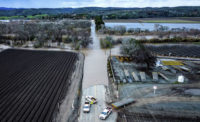

The deadly collapse of three buildings in the historic center of Rio de Janeiro has launched a series of inquiries into the cause of the accident as officials continue to search for the bodies of victims.
The 20-story Liberty Building on Avenida 13 de Maio, located near Cinelandia Square in central Rio, fell at about 8:30 p.m. on Jan. 25. The debris crushed the nearby 10-story Columbus Building as well as a small four-story building that separated the two larger structures.
The death toll stands at 17, but authorities say five people remain missing. More than 45,000 tonnes of rubble created by the collapse has been removed from the site, and officials with the state's emergency management office say they do not expect to find any other survivors.
The collapse occurred next to Rio’s historic municipal theater. Restored in 2009 to mark its centenary anniversary, the building was undamaged. The 22-story Capital Building, constructed flush with the Liberty Building, suffered some damage, but city officials said its structural integrity was not affected.
Initial reports attributed the collapse to a gas leak, as witnesses reported hearing what sounded like a loud explosion at the time. Rio Mayor Eduardo Paes later discounted those reports, saying the incident appeared to be caused by structural problems within the buildings themselves.
Federal police are conducting an investigation into the cause of the collapse and have questioned the owners of the buildings. The Rio de Janiero Council of Architecture and Urbanism is also working with the city on a report that will examine the causes of the accident and whether, for example, there was proper licensing in any remodeling efforts, says Sydnei Menezes, the council's president.
The Liberty Building was constructed of reinforced concrete in about 1940. The two smaller buildings were made of structural masonry. Both methods are common for buildings in Brazil, says Paulo Fernando Neves Rodrigues, professor of architecture at the Federal University of Rio de Janeiro.
All three structures were mostly empty at the time of the collapse. The city’s secretary of civil defense, Sergio Simoes, told reporters on Jan. 28 the likelihood of finding survivors was virtually zero since there did not appear to be any spaces in the rubble.
“The whole structure is compressed either by the sequence of slabs from the main building or by tipping the upper side of the same building, which also caused the break in sequence of the slabs of the other buildings,” reported Agência Brasil, the country’s national broadcasting agency.
As recently as two weeks ago, a wall was removed on the ninth floor of the Liberty Building, according to a worker who survived the collapse. The Regional Council on Engineering and Agronomy, which approves such work in the city, said there was no record of the project and declared it illegal. The building manager denied the allegation, saying the work was done with the city’s permission.











Post a comment to this article
Report Abusive Comment